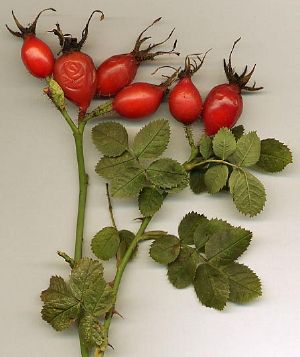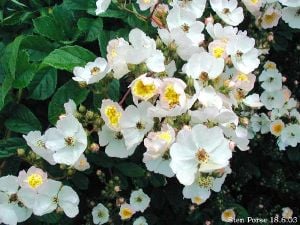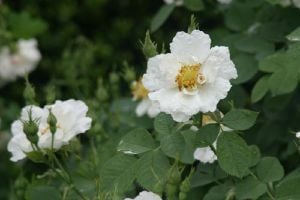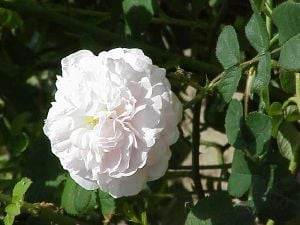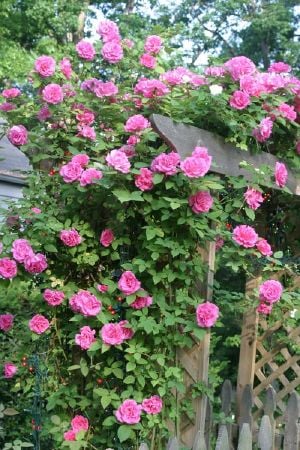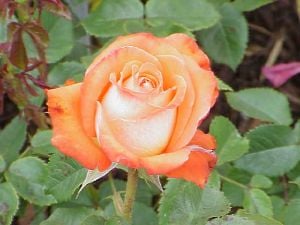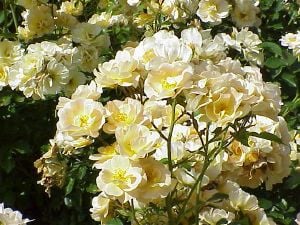Rose
| Rose | ||||||||||||||
|---|---|---|---|---|---|---|---|---|---|---|---|---|---|---|
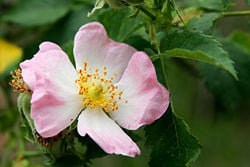 Rosa canina (Dog Rose) flower | ||||||||||||||
| Scientific classification | ||||||||||||||
| ||||||||||||||
| Species | ||||||||||||||
|
About 100, see text |
A rose is a flowering shrub of the genus Rosa and the family Rosaceae, which is one of the largest families of flowering plants with about 3,400 species including apples, berries, peaches, plums, cherries, the hawthorn tree, the mountain ash, and many others.
Wild Roses
There are more than a hundred species of wild roses, all from the northern hemisphere and mostly from temperate regions. The species form a group of generally thorny shrubs or climbers, and sometimes trailing plants, reaching 2–5 m tall, rarely reaching as high as 20 m by climbing over other plants.
The leaves of most species are 5–15 cm long, pinnate, with (3–) 5–9 (–13) leaflets and basal stipules; the leaflets usually have a serrated margin, and often a few small thorns on the underside of the stem. The vast majority of roses are deciduous, but a few (particularly in southeast Asia) are evergreen or nearly so.
The flowers have five petals (with the exception of Rosa sericea which often has only four), usually white or pink, in a few species yellow or red. The ovary is inferior, developing below the petals and sepals.
The fruit of the rose is a berry-like structure called a rose hip. The hips of most species are red, but a few (e.g. Rosa pimpinellifolia) have dark purple to black hips. Each hip comprises an outer fleshy layer, the hypanthium, which contains 5–160 "seeds" (technically dry single-seeded fruits called achenes) embedded in a matrix of fine, but stiff, hairs. Rose hips of some species, especially the Dog Rose (Rosa canina) and Rugosa Rose (Rosa rugosa), are very rich in vitamin C, among the richest sources of any plant. The hips are eaten by fruit-eating birds such as thrushes and waxwings, which then disperse the seeds in their droppings. Some birds, particularly finches, also eat the seeds. People also sometimes eat rose hips, mainly for their vitamin C content. They are usually pressed and filtered to make rose-hip syrup, as the fine hairs surrounding the seeds are unpleasant to eat (resembling itching powder). They can also be used to make herbal tea, jam, jelly]] and marmalade. During World War Two rose hips were an important source of vitamin C in Great Britain when other fruits were scarce.
Most roses have thorns or prickles. The thorns are typically sickle-shaped hooks, which aid the rose in hanging onto other vegetation when growing over it. Some species such as Rosa rugosa and R. pimpinellifolia instead have densely packed straight spines, probably an adaptation to reduce browsing by animals, but also possibly an adaptation to trap wind-blown sand and so reduce erosion and protect their roots (both of these two species grow naturally on coastal sand dunes). Despite the presence of the thorns, roses are frequently browsed by deer. A few species of roses only have vestigial thorns that have no points.
Some representative wild rose species
- Rosa canina - Dog Rose, Briar Bush
- Rosa dumalis - Glaucous Dog Rose
- Rosa eglanteria (syn. R. rubiginosa) - Eglantine, Sweet Brier
- Rosa gallica - Gallic Rose, French Rose
- Rosa gigantea (syn. R. x odorata gigantea)
- Rosa glauca (syn. R. rubrifolia) - Redleaf Rose
- Rosa laevigata (syn. R. sinica) - Cherokee Rose, Camellia Rose, Mardan Rose
- Rosa multiflora - Multiflora Rose
- Rosa persica (syn. Hulthemia persica, R. simplicifolia)
- Rosa roxburghii - Chestnut Rose, Burr Rose
- Rosa rugosa - Rugosa Rose, Japanese Rose
- Rosa stellata - Gooseberry Rose, Sacramento Rose
- Rosa virginiana (syn. R. lucida) - Virginia Rose
Roses in cultivation
Roses were first cultivated in China about 5000 years ago, whether for their beauty or for their edible fruit it is not known. Later they were cultivated in India, Persia, the Middle East, and Europe. In the Ancient Rome roses were very popular, not only for their beauty but also for food and for many medicinal uses. They were also cultivated in the New World. Bernal Díaz del Castillo, who fought in Cortez's army, described the gardens of Mexico City in his book The Discovery and Conquest of Mexico:
- When we had looked well at all of this, we went to the orchard and garden, which was such a wonderful thing to see and walk in, that I was never tired of looking at the diversity of the trees, and noting the scent which each one had, and the paths full of roses and flowers, and the many fruit trees and native roses, and the pond of fresh water.
Modern rose cultivation began in the fifteenth and sixteenth centuries especially in Holland when trading ships brought roses from China. These were crossed with European roses creating many new varieties. The popularity of roses never slowed down and continues today. In 1994, over 1,200,000,000 roses were purchased by U.S. flower buyers; 4.67 per person.[1]
There is no single system of classification for garden roses. In general, however, roses are placed in one of three main groups:
- Wild Roses - The wild roses includes the species listed above and some of their hybrids.
- Old Garden Roses - Most old garden roses are classified into one of the following (ordered by approximate age - oldest first):
- Alba - Literally "white roses", derived from R. arvensis and the closely allied R. alba. These are some of the oldest garden roses, probably brought to Great Britain by the Romans. Once-flowering. Examples: 'Semi-plena', 'White Rose of York'.
- Gallica - The Gallica roses have been developed from R. gallica which is a native of central and southern Europe. They flower once in the summer. Examples: 'Cardinal de Richelieu', 'Charles de Mills', 'Rosa Mundi' (R. gallica versicolor).
- Damask - Robert de Brie is given credit for bringing them from Persia to Europe sometime between 1254 and 1276. Summer Damasks (crosses between Gallica roses and R. phoenicea) bloom once in summer. Autumn Damasks (Gallicas crossed with R. moschata) bloom later, in the autumn. Examples: 'Ispahan', 'Madame Hardy'.
- Centifolia (or Provence) - These roses, raised in the Seventeenth Century in the Netherlands, are named for their "one hundred" petals. Once-flowering. Examples: 'Centifolia', 'Paul Ricault'.
- Moss - Closely related to the centifolias, these have a mossy excrescence on the stems and sepals. Once-flowering. Example: 'Comtesse de Murinais', 'Old Pink Moss'.
- China - The China roses brought with them an amazing ability to bloom repeatedly throughout the summer and into late autumn. Four china roses ('Slater's Crimson China', 1792; 'Parsons' Pink China', 1793; 'Hume's Blush China', 1809; and 'Parks' Yellow Tea Scented China', 1824) were brought to Europe in the late Eighteenth and Nineteenth centuries which brought about the creation of the repeat flowering old garden roses and later the modern garden roses. Examples: 'Old Blush China', 'Mutabilis'.
- Portland - These are named after the Duchess of Portland who received (from Italy in 1800) a rose then known as R. paestana or 'Scarlet Four Seasons' Rose' (now known simply as 'The Portland Rose'). This group was developed from that rose. Repeat-flowering. Example: 'James Veitch', 'Rose de Rescht', 'The Portland Rose'.
- Bourbon - They originated on l'Île de Bourbon (now called Réunion). Probably the result of a cross between the Autumn Damask and the 'Old Blush China'. Introduced in France in 1823. Repeat-flowering. Examples: 'Louise Odier', 'Mme. Pierre Oger', 'Zéphirine Drouhin'.
- Hybrid Perpetual - The dominant class of roses in Victorian England, they were derived to a great extent from the Bourbons. Repeat-flowering. Examples: 'Ferdinand Pichard', 'Reine Des Violettes'.
- Tea - The result of crossing two of the original China Roses ('Hume's Blush China' and 'Parks' Yellow Tea Scented China') with various Bourbons and Noisette roses. Somewhat more tender than other old garden roses (most likely because of R. gigantea in the ancestry of the Parks rose), teas are repeat-flowering roses although their fragrance is not always a tea scent. Example: 'Lady Hillingdon'.
- Bermuda "Mystery" Roses - A group of several dozen "found" roses that have been grown in Bermuda for at least a century. The roses have significant value and interest for those growing roses in tropical and semi-tropical regions, since they are highly resistant to both nematode damage and the fungal diseases that plague rose culture in hot, humid areas, and capable of blooming in hot and humid weather. Most of these roses are likely Old Garden Rose cultivars that have otherwise dropped out of cultivation, or sports thereof. They are "mystery roses" because their "proper" historical names have been lost. Tradition dictates that they are named after the owner of the garden where they were rediscovered.
- Miscellaneous - There are also a few smaller classes (such as Scots, Sweet Brier) and some climbing classes of old roses (including Ayrshire, Climbing China, Laevigata, Sempervirens, Noisette, Boursault, Climbing Tea, and Climbing Bourbon). Those classes with both climbing and shrub forms are often grouped together.
- Modern Garden Roses - Classification of modern roses can be quite confusing because many modern roses have old garden roses in their ancestry and their form varies so much. The classifications tend to be by growth and flowering characteristics, such as "large-flowered shrub", "recurrent, large-flowered shrub", "cluster-flowered", "rambler recurrent", or "ground-cover non-recurrent". Many of the most popular modern cultivars can however be assigned to one of these two groups:
- Hybrid Tea - The "long stem" rose. Most roses sold by florists and at roadside flower stands are Hybid Teas. They typically have one to at most five or six large flowers per stem, the flower with numerous tightly arranged petals with reflexed tips (see photo, right). They are favoured in small gardens in formal situations, and for buttonhole roses.
- Floribunda - Flowers often smaller, in large clusters of ten or more (often many more) on each stem. These tend to give a more prominent display from a distance, so are more often used in large bedding schemes in public parks and similar spaces.
Roses and culture
Roses are ancient symbols of love and beauty. The rose was sacred to a number of goddesses (including Isis and Aphrodite), and is often used as a symbol of the Virgin Mary. Roses are so important that the word means pink or red in a variety of languages (such as Romance languages, Greek, and Polish).
The rose is the national flower of England and the United States, as well as being the symbol of England Rugby, and of the Rugby Football Union. It is also the provincial flower of Yorkshire in England (the white rose) and of Alberta (the wild rose), and the state flower of four US states: Iowa and North Dakota (R. arkansana), Georgia (R. laevigata), and New York (Rosa generally). Portland, Oregon counts "City of Roses" among its nicknames, and holds an annual Rose Festival.
Roses are ocassionally the basis of design for rose windows, such windows comprising five or ten segments (the five petals and five sepals of a rose) or multiples thereof; however most Gothic rose windows windows are much more elaborate and were probably based originally on the wheel and other symbolism.
A red rose (often held in a hand) is also a symbol of socialism or social democracy; it is also used as a symbol by the British and Irish Labour Parties, as well as by the French, Spanish (Spanish Socialist Workers' Party), Portuguese, Norwegian, Danish, Swedish, Finnish, Brazilian, Dutch (Partij van de Arbeid) and European socialist parties. This originates from the red rose used as a badge by the marchers in the May 1968 street protests in Paris.
The rose came to symbolize the Republic of Georgia's non-violent bid for freedom during its Rose Revolution.
The symbol of a rose can also refer to the red rose of Lancaster, and the white rose of York, from the Wars of the Roses period.
Mythology and Superstition
- In some pagan mythologies, no undead or ghostly creatures (particularly vampires) may cross the path of a wild rose. It was thought that to place a wild rose on a coffin of a recently deceased person would prevent them from rising again. (This particular myth was a plot device used in the 2006 movie, Stay Alive.)
- Since the earliest times, the rose has been an emblem of silence:
- In Greek Mythology, Eros presents a rose to the god of silence.
- The phrase sub rosa or "under the rose", means to keep a secret—derived from the ancient Roman practice of placing a wild rose on the door of a room in which a confidential discussion or meeting was being held.
- In a Celtic folk legend, a wandering, screaming spirit was silenced by presenting the spirit with a wild rose every new moon.
- Roses were used in very early times as a very potent ingredient in love philters.
- According to Indian mythology, one of the wives of Vishnu was found inside a rose.
- In Rome it was often customary to bless roses on "Rose Sunday".
- In the east it is still believed that the first rose was created from a tear of the prophet Mohammed, and it is further believed that on a certain day in the year the rose has a heart of gold.
- In Scotland, if a white rose bloomed in autumn it was a token of an early marriage.
- The red rose, it is believed by many religions, cannot grow over a grave.
- Rose leaves thrown into a burning flame are said to give good luck.
- If a young girl had more than one lover, it is believed in one mythology, she should take rose leaves and write the names of her lovers upon them before casting them into the wind. The last leaf to reach the ground would bear the name of the lover whom she should marry.
- It is believed that if a rose bush were pruned on St. John's Eve, it would be guaranteed to bloom in the autumn.
Roses in art
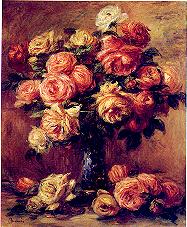
Roses are often portrayed by artists. The French artist Pierre-Joseph Redouté produced some of the most detailed paintings of roses.
Perfume
Rose perfumes are made from attar of roses or rose oil, which is a mixture of volatile essential oils obtained by steam-distilling the crushed petals of roses. The technique originated in Persia (the word Rose itself is from Persian) then spread through Arabia and India, but nowadays about 70% to 80% of production is in the Rose Valley near Kazanluk in Bulgaria, with some production in Qamsar in Iran and Germany. The Kaaba in Mecca is annually washed by the Iranian rose water from Qamsar. In Bulgaria, Iran and Germany, damask roses (Rosa damascena 'Trigintipetala') are used. In the French rose oil industry Rosa centifolia is used. The oil, pale yellow or yellow-grey in color, is sometimes called 'Rose Absolute' oil to distinguish it from diluted versions. The weight of oil extracted is about one three-thousandth to one six-thousandth of the weight of the flowers - for example, about 2,000 flowers are required to produce one gramme of oil.
The main constituents of attar of roses are the fragrant alcohols geraniol, which has the empirical formula C10H18O and the structural formula CH3.C[CH3]:CH.CH2.CH2.C[CH3]:CH.CH2OH and l-citronellol; and rose camphor, an odourless paraffin.
The Peace Rose
The Peace rose is the the most famous and successful garden rose of all time. Over one hundred million plants have been sold. It is a Hybrid Tea with very large flowers and a light yellow to cream color. It is very hardy and resistant to disease making it popular in gardens as well as in the floral trade.
It was developed by French horticulturist Francis Meilland in the years 1935 to 1939. When Meilland foresaw the German invasion of France he sent cuttings to friends in Italy, Turkey, Germany, and the United States to protect the new rose. It was in the United States that it was given the name Peace on April 29, 1945. This was the very day that Berlin fell, officially considered the end of the Second World War in Europe. Later that year Peace roses were given to each of the delegations at the inaugural meeting of the United Nations in San Francisco, each with a note that read: “We hope the ‘Peace’ rose will influence men’s thoughts for everlasting world peace.”
Peter Beales, English rose grower and expert, said in his book Roses: "'Peace', without doubt, is the finest Hybrid Tea ever raised and it will remain a standard variety forever."
Notable rose growers
Notable rose growers include:
- David Austin ("English" roses)
- Peter Beales
- Joséphine de Beauharnais
- Griffith Buck, professor of horticulture at Iowa State University from 1948 to 1985, hybridized nearly 90 rose varieties. Buck roses are known for disease resistance and winter hardiness.
- Conard-Pyle Co. (Star Roses)
- Jules Gravereaux
- Jean-Baptiste Guillot
- Meilland family
- Jean Pernet, père
- Joseph Pernet-Ducher
External links and references
- Easy and Elegant Rose Design, E. S. Platt, photographs by A. Detrick. Fulcrum Publishing, ISBN 1555914764
- HelpMeFind Roses. Information on roses, including contributions from the community.
- Paul Barden's "Old Garden Roses and Beyond". Dedicated to Old Garden Roses and select shrub and miniature roses of the 20th century.
- Dr. Griffith Buck Roses
- Pruning Recommendations from University of Illinois Extension
- Beales, Peter, Roses, New York : Henry Holt and Company, 1985 ISBN 0805020535
- Del Castillo, Bernal Diaz, The Discovery and Conquest of Mexico: 1517-1521 Maudslay, A. P. translator 2003 Cambridge, MA : Del Capo Press ISBN 030681319X
- Haughton, Claire Shaver, Green Immigrants, New York : Harcourt Brace Jovanovich, Inc. 1978 ISBN 0151370346
Credits
New World Encyclopedia writers and editors rewrote and completed the Wikipedia article in accordance with New World Encyclopedia standards. This article abides by terms of the Creative Commons CC-by-sa 3.0 License (CC-by-sa), which may be used and disseminated with proper attribution. Credit is due under the terms of this license that can reference both the New World Encyclopedia contributors and the selfless volunteer contributors of the Wikimedia Foundation. To cite this article click here for a list of acceptable citing formats.The history of earlier contributions by wikipedians is accessible to researchers here:
The history of this article since it was imported to New World Encyclopedia:
Note: Some restrictions may apply to use of individual images which are separately licensed.
